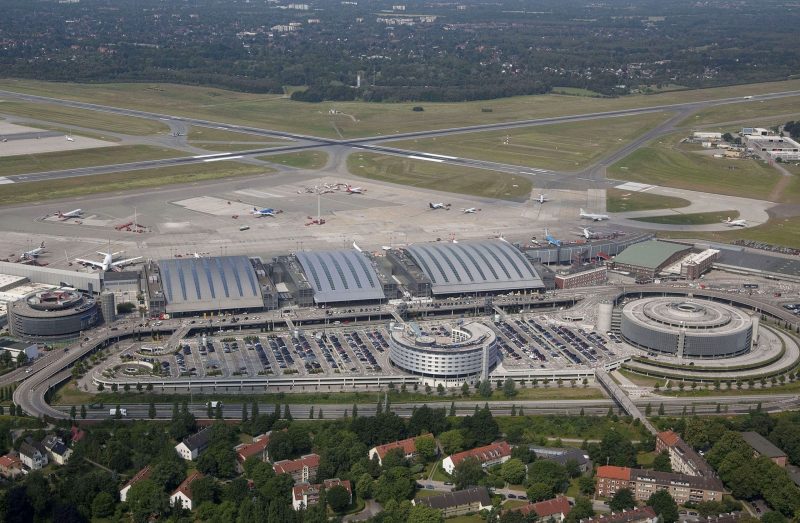Exactly 241 passengers were counted at Hamburg Airport at the beginning of the records in 1920 - in 2019 there were already more than 17 million. And today the airport in the Hanseatic city is celebrating its 111th birthday. This makes it one of the oldest international airports in the world and is still where it was founded.
The history of Hamburg Airport began back in March 1910: Count Ferdinand von Zeppelin promoted the future of airships in a speech to numerous Hamburg residents. His appeal bore fruit: On January 10, 1911, Hamburger Luftschiffhallen GmbH (HLG) was established - the birth of Hamburg Airport. The first airship hangar was built on a meadow area of almost 45 hectares near the village of Fuhlsbüttel, from where the first airships took off as early as 1912. The Zeppelin Hall was inaugurated in 1912 with a large folk festival.

The zeppelins were quickly replaced by the first aircraft
Equipped with a scarf, helmet and aviator goggles, up to five passengers were on the move in the open double-decker in the early years. Scheduled flight connections were established in Hamburg for the first time in 1919/20 - for example, it went from Hamburg to Berlin in converted war machines. In 1920 KLM flew the first international connection via Hamburg: Rotterdam - Amsterdam - Hamburg - Copenhagen. During this time, the number of passengers also rose sharply. In 1929 the first terminal building opened at the airport, which centralized the handling of passengers and cargo, the airport administration as well as a restaurant and viewing platforms.
Fuhlsbüttel Airport becomes "Hamburg Airport"
During the Berlin Airlift, Hamburg Airport was one of the departure airports for the so-called raisin bombers. At the airport, which had not suffered any damage from the war, the management passed to the British Army until 1950: from then on the site was called "Hamburg Airport" - a name that officially replaced the name Fuhlsbüttel Airport from 2000 onwards. On April 1, 1955, the new Deutsche Lufthansa took off from Hamburg with a Convair aircraft on its maiden flight in the direction of Munich. And in 1960 Hamburg Airport celebrated another premiere: the first Lufthansa jet aircraft landed in Hamburg with a Boeing 707.

1961: The number of passengers exceeds one million for the first time
In order to do justice to the new passenger jets, the airport extended its runways. This enlarged the site to around 1960 hectares in the 500s - a size that has remained almost unchanged to this day. The number of passengers, on the other hand, kept reaching new heights. After the Second World War, aviation boomed: in 1951 almost 212.000 people traveled via Hamburg Airport, and in 1961 the million mark was exceeded for the first time.

The 70s: more passengers with fewer planes
On March 30, 1970, Lufthansa's first wide-body aircraft, a Boeing 747, landed in Hamburg. Thousands of onlookers came to greet them. During this time, Concorde visited Hamburg Airport only once - in April 1976. The sudden increase in air traffic meant that politicians in Hamburg and Schleswig-Holstein spoke out about relocating air traffic to Kaltenkirchen. The Kaltenkirchen plans were shelved again. Instead, Hamburg Airport had to grow internally.

Expansion of the airport on site
The expansion at the site included the construction of a new terminal, 11 new passenger boarding bridges and a new multi-storey car park. As a highlight, Terminal 1993 (now Terminal 4) went into operation in 2. The architect of the new terminal, the curved roof of which is modeled on the wings of an airplane, was Meinhard von Gerkan. In the same year, Hamburg Airport counted over 7 million passengers for the first time. The largest expansion program, HAM21, began in the new millennium: by the end of 2009, the Airport Plaza, two passenger terminals, a dynamic parking guidance system, wide driveways, additional parking spaces, a separate S-Bahn connection and a comfort hotel were built.
Hamburg Airport Helmut Schmidt
In honor of the former Federal Chancellor Helmut Schmidt, the airport was given the name “Hamburg Airport Helmut Schmidt” on November 10, 2016. The statesman had a special connection with Hamburg Airport - both as honorary chairman of the supervisory board and as a neighbor from Langenhorn. Since then, a permanent exhibition in Terminal 2 pays tribute to the life's work of Helmut and Loki Schmidt. The exhibition was opened by today's Federal Chancellor Olaf Scholz, who was then First Mayor of the Free and Hanseatic City of Hamburg and often a guest at Hamburg Airport.

The following year, on July 7th and 8th, 2017, the G20 summit took place in Hamburg. Over 100 special aircraft from various governments were handled in parallel with regular flight operations. On October 29, 2018, Hamburg Airport welcomed an Emirates scheduled flight with the Airbus A380 for the first time as an A380 certified airport.
Corona: slump in air traffic
After a successful 2019 with more than 17 million passengers, extensive investments in infrastructure, environmental protection and noise protection, the corona pandemic with its economic consequences has also hit air traffic in Hamburg hard since March 2020. After almost two years of largely standing still in the aviation industry, the volume of traffic at Hamburg Airport is recovering, but only slowly. At the same time and at an early stage, the airport took numerous measures to reduce costs and position itself sustainably for the future.
Interested parties can find more information on the history of Hamburg Airport and the birthday video “A city congratulates” on the website: Our history - Hamburg Airport (hamburg-airport.de).







 trail (for them it's free to use)
trail (for them it's free to use)